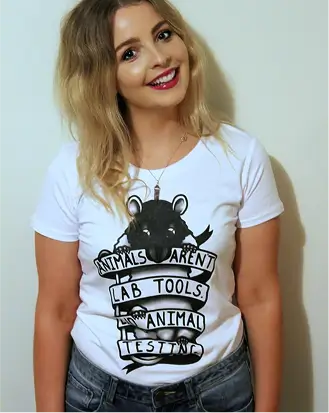Animals Used in Unwanted Species Research
HOW TO DEAL WITH UNWANTED SPECIES
Our position on this issue is clear. When trying to find ways of controlling the populations of ‘unwanted’ or invasive species, NZAVS is firmly against any type of research method that causes harm to animals. Including using deadly traps or poisoning and shooting animals.
There are many invasive research methods used in Aotearoa to try and deal with the problem we created by bringing these species here, including:
- Feeding poison to animals, including wallabies, rats, mice, possums,1 stoats, cats, and dogs.2
- Poisoning possums to then feed them to cats, dogs and chickens.3
- Trapping animals with wire cages or leg traps,4 where it is deemed acceptable to only check them once in 16 hours.5
- And more!
Note: Poisoning, trapping, and shooting animals are all permitted under the Animal Welfare Act.6
The ways that animals are used in NZ for research into unwanted species and population control are vast. Some of these experiments will shock you.
For example, ten stoats were put into a water-filled flume with a continuous current flowing through it; the aim was to find out how far stoats can swim (i.e., can they swim to remote islands where native and endangered birds live?). One of the stoats swam for nearly two hours – an incredibly long time for an animal to be treading water! One stoat panicked and had to be removed from the water after a few minutes.7
NON-HARMFUL RESEARCH
There is some research going on within New Zealand into non-harmful population control methods.
For example, genetic intervention to make a species (or only males) infertile.8 But a lot of it is still aimed at understanding the basics.9
Find out more about the non-harmful research happening in NZ here.
Sadly, non-invasive research is rare in this area. Even the Environmental Protection Authority (EPA) is not working on or funding any research into non-invasive species control and has not previously worked on or funded any such research.10
For things to change, researchers need a financial incentive to focus on alternative (and kinder) methods of controlling unwanted species.
We urgently need funding to be available to develop better research methods that don’t involve killing thousands of animals.
HOW WE GOT HERE
We need to look back on our history to see how we ended up in this position - with so many unwanted animals who threaten our native species.
Humans have introduced many animals to Aotearoa, such as possums, who were introduced to establish a fur trade. The early Polynesian settlers brought with them their dogs and the Pacific rat.11 European, American, and other settlers introduced many other animals (intentionally in most cases) for farming, trade, or sport. In terms of mammalian predators alone, humans introduced 12 new species to our native animals and plants.
Most of the damage to the native ecosystem was done through European logging, fire, and drainage, diminishing the wetlands by around 90%.12 Forests were diminished from around 85% land cover to 53%. Wetland and forest loss have been most significant in the last 150 years because of the expansion of farmland and the development of urban settlements. Over two-thirds of indigenous land cover has been converted to pastures, exotic forests, and settlements, with animal agriculture contributing further issues to our environment.13
Sadly, we are now suffering the consequences. Since the arrival of humans, 82 species have been lost. Over 4,200 native plant and animal species are currently threatened, or at risk of extinction,14 and our wetlands are now under great threat.15
THE TRICKY SOLUTION
NZ needs to focus on conducting and funding research into non-harmful ways of managing the populations of unwanted species!
However, this issue is complex and there are many things to consider including:
- The ethical dilemma of protecting one species without harming the other. As reviewed by scientists recently,16 even a compassionate theoretical approach to conservation cannot avoid direct harm to individual animals in practice.
- The impact that different methods might have in different areas,7and there won’t be one single solution that can work across all the different unwanted species.
- The complexity of ecosystems and the risks involved in altering these. Ecosystems involve complex relationships between different species, and changes to one species or process can have unexpected effects on others. Ecosystem-focused conservation addresses the whole picture (as much as possible because there is still a lot to learn), having a functional system in focus rather than a (few) singular species.18
- Keeping strategies factual and measurable to avoid them becoming mere political tools failing to constitute real progress.19 As shown in Australia, simply killing as many individuals as possible can have undesirable outcomes and might even backfire.20
- The normalisation of lethal methods (poisoning, killing etc.) decreases motivation to invest in research on compassionate alternatives.21
New Zealand’s Predator Free 2050 program has been criticised for focusing on predator eradication. Predator suppression, habitat protection and restoration, and prey sanctuaries can sometimes better support threatened biodiversity.22
To achieve a resilient future ecosystem within New Zealand, contemporary science as well as Mātauranga Māori science and local knowledge should inform management decisions. It also needs to be acknowledged that projects are not only funded by the government but also by local iwi, businesses, philanthropy, non-government organisations and local communities.23
Non-native species undoubtedly harm our native birds and reptiles, regardless of how low their population gets. So, the complete removal of these species would be the ideal way to protect native species long-term in the eyes of many. Yet, as we have seen with Covid-19, successfully dealing with a problem does not provide any guarantee that it will not reoccur.
So, rather than taking drastic measures to wipe out unwanted species from our country, we should focus more on bringing predator populations down to a manageable level and instead increase the protection of our native fauna.
Yes, every kiwi bird chick, every tuatara, and every native sapling is precious. But the cats, rats, possums, and rabbits did not ask to be here. We, humans, brought them here and caused this difficult situation in the first place. The least we can do is keep compassion for all sentient beings in our minds when we try to find solutions.
WHAT NZAVS IS DOING
To see change, we need funding to go towards better research methods that don’t involve killing thousands of animals. This is exactly what we are asking for with our Striking at the Source campaign.
- https://doi.org/10.1080/03014223.2019.1657473
- https://www.researchgate.net/publication/237373415
- https://doi.org/10.20417/nzjecol.42.6
- https://newzealandecology.org/nzje/2938
- Information obtained via OIA-request
- https://www.doc.govt.nz/nature/pests-and-threats/animal-pests/feral-cats/
- https://hdl.handle.net/10289/9408
- https://doi.org/10.1111/mec.16361
- https://pf2050.co.nz/current-research-projects/
- EPA communication via OIA-request
- https://www.otago.ac.nz/press/books/otago756055.html
- https://newzealandecology.org/nzje/2889
- https://environment.govt.nz/publications/the-state-of-new-zealands-environment-1997/
- https://nztcs.org.nz/
- https://www.researchgate.net/publication/240311149
- https://doi.org/10.3389/fpsyg.2022.750313
- https://doi.org/10.1111/nyas.14651
- https://doi.org/10.1016/S0006-3207(00)00192-0
- https://doi.org/10.1111/conl.12633
- https://doi.org/10.1071/WR14030
- https://doi.org/10.1111/cobi.12896
- https://doi.org/10.1111/conl.12593
- https://doi.org/10.1111/emr.12230





